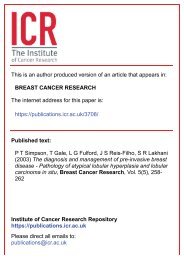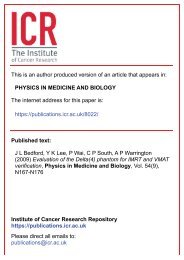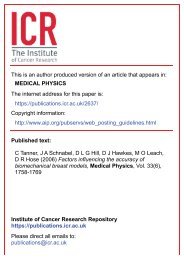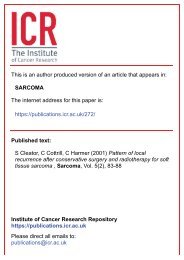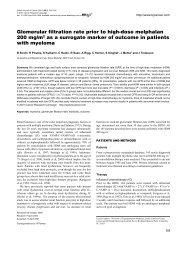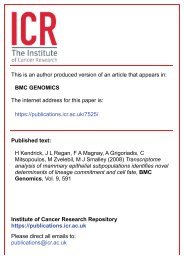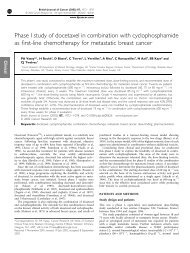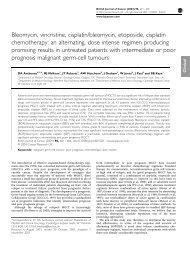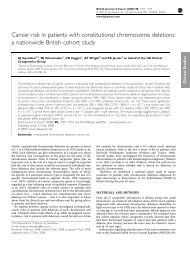Risk factors for adenocarcinoma and squamous cell carcinoma of ...
Risk factors for adenocarcinoma and squamous cell carcinoma of ...
Risk factors for adenocarcinoma and squamous cell carcinoma of ...
You also want an ePaper? Increase the reach of your titles
YUMPU automatically turns print PDFs into web optimized ePapers that Google loves.
British Journal <strong>of</strong> Cancer (2003) 89, 2078 – 2086& 2003 Cancer Research UK All rights reserved 0007 – 0920/03 $25.00www.bjcancer.com<strong>Risk</strong> <strong>factors</strong> <strong>for</strong> <strong>adeno<strong>carcinoma</strong></strong> <strong>and</strong> <strong>squamous</strong> <strong>cell</strong> <strong>carcinoma</strong> <strong>of</strong>the cervix in women aged 20–44 years: the UK NationalCase – Control Study <strong>of</strong> Cervical CancerEpidemiologyJ Green* ,1 , A Berrington de Gonzalez 1 , S Sweetl<strong>and</strong> 1 , V Beral 1 , C Chilvers 2 , B Crossley 1 , J Deacon 3 , C Hermon 1 ,P Jha 4 , D Mant 5 , J Peto 3,6 , M Pike 7 <strong>and</strong> MP Vessey 81 Cancer Research UK Epidemiology Unit, University <strong>of</strong> Ox<strong>for</strong>d, Gibson Building, Radcliffe Infirmary, Ox<strong>for</strong>d OX2 6HE, UK; 2 Research <strong>and</strong> DevelopmentOffice, Department <strong>of</strong> Health, Nottingham, UK; 3 Institute <strong>of</strong> Cancer Research, Sutton, Surrey, UK; 4 Department <strong>of</strong> Public Health Sciences, University <strong>of</strong>Toronto, Ontario, Canada;5 Department <strong>of</strong> Primary Health Care, Institute <strong>of</strong> Health Sciences, Ox<strong>for</strong>d, UK;6 London School <strong>of</strong> Hygiene <strong>and</strong> TropicalMedicine, London, UK;7 Department <strong>of</strong> Preventive Medicine, Keck School <strong>of</strong> Medicine, University <strong>of</strong> Southern Cali<strong>for</strong>nia, USA;8 Unit <strong>of</strong> Health CareEpidemiology, Department <strong>of</strong> Public Health, Institute <strong>of</strong> Health Sciences, Ox<strong>for</strong>d, UKWe report results on risk <strong>factors</strong> <strong>for</strong> invasive <strong>squamous</strong> <strong>cell</strong> <strong>and</strong> <strong>adeno<strong>carcinoma</strong></strong>s <strong>of</strong> the cervix in women aged 20–44 years from theUK National Case–Control Study <strong>of</strong> Cervical Cancer, including 180 women with <strong>adeno<strong>carcinoma</strong></strong>, 391 women with <strong>squamous</strong> <strong>cell</strong><strong>carcinoma</strong> <strong>and</strong> 923 population controls. The risk <strong>of</strong> both <strong>squamous</strong> <strong>cell</strong> <strong>and</strong> <strong>adeno<strong>carcinoma</strong></strong> was strongly related to the lifetimenumber <strong>of</strong> sexual partners, <strong>and</strong>, independently, to age at first intercourse. The risk <strong>of</strong> both types <strong>of</strong> cervical cancer increased withincreasing duration <strong>of</strong> use <strong>of</strong> oral contraceptives, <strong>and</strong> this effect was most marked in current <strong>and</strong> recent users <strong>of</strong> oral contraceptives.The risk <strong>of</strong> <strong>squamous</strong> <strong>cell</strong> <strong>carcinoma</strong> was associated with high parity <strong>and</strong> the risk <strong>of</strong> both <strong>squamous</strong> <strong>cell</strong> <strong>and</strong> <strong>adeno<strong>carcinoma</strong></strong>increased with early age at first birth. Long duration smoking (20 or more years) was associated with a two-fold increase in the risk <strong>of</strong><strong>squamous</strong> <strong>cell</strong> <strong>carcinoma</strong>, but smoking was not associated with the risk <strong>of</strong> <strong>adeno<strong>carcinoma</strong></strong>. Further studies are needed to confirm thesuggestion from this <strong>and</strong> other studies <strong>of</strong> differences in risk related to smoking between <strong>squamous</strong> <strong>cell</strong> <strong>and</strong> <strong>adeno<strong>carcinoma</strong></strong>s <strong>of</strong> thecervix.British Journal <strong>of</strong> Cancer (2003) 89, 2078–2086. doi:10.1038/sj.bjc.6601296 www.bjcancer.com& 2003 Cancer Research UKKeywords: cervix neoplasms; risk <strong>factors</strong>; <strong>adeno<strong>carcinoma</strong></strong>; <strong>squamous</strong> <strong>cell</strong> <strong>carcinoma</strong>Among cancers <strong>of</strong> the uterine cervix, <strong>adeno<strong>carcinoma</strong></strong>s are muchless common than <strong>squamous</strong> <strong>cell</strong> <strong>carcinoma</strong>s. As <strong>for</strong> <strong>squamous</strong> <strong>cell</strong><strong>carcinoma</strong>, human papillomavirus (HPV) infection appears to be amajor risk factor <strong>for</strong> <strong>adeno<strong>carcinoma</strong></strong> <strong>of</strong> the cervix (Kjaer <strong>and</strong>Brinton, 1993; Walboomers et al, 1999; Santos et al, 2001;Altekruse et al, 2003), but evidence on other <strong>factors</strong> that mayaffect the risk <strong>of</strong> <strong>adeno<strong>carcinoma</strong></strong> is limited <strong>and</strong> not entirelyconsistent (Parazzini <strong>and</strong> La Vecchia, 1990; Kjaer <strong>and</strong> Brinton,1993; Ursin et al, 1994, 1996; Lacey et al, 1999, 2000, 2001;Madeleine et al, 2001; Altekruse et al, 2003). The question <strong>of</strong>whether there are substantial differences in the risk <strong>factors</strong> <strong>for</strong><strong>adeno<strong>carcinoma</strong></strong>s <strong>and</strong> <strong>squamous</strong> <strong>cell</strong> <strong>carcinoma</strong>s remains unresolved.Few epidemiological studies have been designed specificallyto provide a direct comparison between <strong>adeno<strong>carcinoma</strong></strong> <strong>and</strong><strong>squamous</strong> <strong>cell</strong> <strong>carcinoma</strong> <strong>of</strong> the cervix, <strong>and</strong> most studies <strong>of</strong> cervical<strong>carcinoma</strong> have had too few cases <strong>of</strong> <strong>adeno<strong>carcinoma</strong></strong> to allow fullevaluation <strong>of</strong> the possible risk <strong>factors</strong>. We present here resultsfrom the UK National Case–Control Study <strong>of</strong> Cervical Cancer, acase–control study <strong>of</strong> risk <strong>factors</strong> <strong>for</strong> invasive cervical cancer inwomen under 45 years old at diagnosis, with 180 cases <strong>of</strong><strong>adeno<strong>carcinoma</strong></strong> (including adeno<strong>squamous</strong> <strong>carcinoma</strong>), 391 cases*Correspondence: Dr J Green; E-mail: Jane.Green@cancer.org.ukReceived 14 July 2003; revised 30 July 2003; accepted 6 August 2003<strong>of</strong> <strong>squamous</strong> <strong>cell</strong> <strong>carcinoma</strong> <strong>and</strong> 923 population controls.In<strong>for</strong>mation was available <strong>for</strong> all study subjects on sexual <strong>and</strong>reproductive <strong>factors</strong>, cervical screening, body weight, smoking <strong>and</strong>the use <strong>of</strong> barrier <strong>and</strong> hormonal contraceptives. Additionalin<strong>for</strong>mation was collected on HPV serology <strong>for</strong> a subgroup <strong>of</strong>subjects, <strong>and</strong> <strong>for</strong> this subgroup results have previously beenpublished on the relationship between HPV positivity <strong>and</strong> risk <strong>of</strong>cervical cancer (Jha et al, 1993), <strong>and</strong> on oral contraceptive use as arisk factor <strong>for</strong> cervical cancer in relation to HPV positivity(Berrington et al, 2002).METHODSRecruitment took place between 1987 <strong>and</strong> 1989. Cases were whitewomen with biopsy-confirmed invasive cervical cancer diagnosedat age 20–44 years in the UK between 1984 <strong>and</strong> 1988, selected fromfive UK Cancer Registries (South Thames, Ox<strong>for</strong>dshire, Lothian,North Western <strong>and</strong> Yorkshire), with additional cases from hospitaltreatment centres. Squamous <strong>cell</strong> <strong>and</strong> <strong>adeno<strong>carcinoma</strong></strong> cases werefrequency matched by age group; the mean (<strong>and</strong> median) age <strong>of</strong><strong>squamous</strong> <strong>cell</strong> <strong>carcinoma</strong> cases was 33 years <strong>and</strong> <strong>of</strong> <strong>adeno<strong>carcinoma</strong></strong>cases was 35 years. For each woman with cervical cancer,between one <strong>and</strong> three control women matched <strong>for</strong> age (within 12
<strong>Risk</strong> <strong>factors</strong> <strong>for</strong> <strong>carcinoma</strong> <strong>of</strong> the cervixJ Green et al2080Table 1 Odds ratios (ORs) <strong>and</strong> 95% confidence intervals (CIs) <strong>for</strong> <strong>adeno<strong>carcinoma</strong></strong>s <strong>and</strong> <strong>squamous</strong> <strong>cell</strong> <strong>carcinoma</strong>s <strong>of</strong> the cervix in relation to sexualbehaviour <strong>and</strong> body weightAdeno<strong>carcinoma</strong> Squamous <strong>cell</strong> <strong>carcinoma</strong> Squamous vs <strong>adeno<strong>carcinoma</strong></strong>Cases/controls OR a 95% CI Cases/controls OR b 95% CI Squamous/adeno cases OR c 95% CILifetime number <strong>of</strong> sexual partners1 52/417 1.00 60/417 1.00 60/52 1.002 –4 84/330 1.96 1.31 – 2.93 186/330 3.31 2.34 – 4.70 186/84 1.65 1.00 – 2.735+ 44/176 1.98 1.21 – 3.26 145/176 4.09 2.75 – 6.08 145/44 1.78 1.00 – 3.18Trend test P ¼ 0.1 Po0.0001 P ¼ 0.3Lifetime number <strong>of</strong> regular sexual partners(3+ months) a0 or 1 63/499 1.00 91/499 1.00 91/63 1.002 60/223 1.97 1.29 – 3.02 111/223 2.30 1.62 – 3.27 111/60 1.01 0.61 – 1.673+ 57/201 2.18 1.36 – 3.47 189/201 3.40 2.38 – 4.86 189/57 1.63 0.97 – 2.71Trend P ¼ 0.003 Po0.0001 P ¼ 0.03EpidemiologyLifetime number <strong>of</strong> nonregular sexualpartners b0 101/603 1.00 170/603 1.00 170/101 1.001 –4 66/251 1.26 0.85 – 1.87 163/251 1.39 1.02 – 1.89 163/66 1.09 0.70 – 1.705+ 13/69 0.75 0.37 – 1.52 58/69 1.29 0.80 – 2.07 58/13 1.28 0.60 – 2.75Trend P ¼ 0.3 P ¼ 0.5 P ¼ 0.5Age at first intercourse (years)20+ 32/283 1.00 42/283 1.00 42/32 1.0018 –19 57/297 1.41 0.86 – 2.32 103/297 1.43 0.93 – 2.20 103/57 1.03 0.55 – 1.92p17 91/343 2.01 1.23 – 3.30 246/343 2.70 1.78 – 4.11 246/91 1.38 0.75 – 2.55Trend P ¼ 0.004 Po0.0001 P ¼ 0.2Weight at reference age (kg) co55 52/289 1.00 141/289 1.00 141/52 1.0055 –64 82/359 1.25 0.84 – 1.86 151/359 0.95 0.70 – 1.30 151/82 0.71 0.45 – 1.1365+ 45/273 1.00 0.63 – 1.57 99/273 0.85 0.61 – 1.20 99/45 0.90 0.54 – 1.52Trend P ¼ 0.7 P ¼ 0.4 P ¼ 0.8Body mass index at reference age cNormal (20 –24.9) 104/540 1.00 228/540 1.00 228/104 1.00Overweight/obese (25+) 40/219 0.98 0.64 – 1.49 78/219 0.87 0.62 – 1.23 78/40 0.89 0.55 – 1.46Underweight (o20) 35/162 1.16 0.74 – 1.81 85/162 1.11 0.79 – 1.55 85/35 0.90 0.54 – 1.49OR a , odds ratio <strong>for</strong> <strong>adeno<strong>carcinoma</strong></strong> vs controls; OR b , odds ratio <strong>for</strong> <strong>squamous</strong> <strong>cell</strong> <strong>carcinoma</strong> vs controls; OR c , odds ratio <strong>for</strong> <strong>squamous</strong> <strong>cell</strong> <strong>carcinoma</strong> cases vs <strong>adeno<strong>carcinoma</strong></strong>cases; all adjusted <strong>for</strong> age, region, smoking, duration <strong>of</strong> oral contraceptive use, number <strong>of</strong> negative screening results <strong>and</strong> education <strong>and</strong> adjusted as appropriate <strong>for</strong> total number <strong>of</strong>sexual partners <strong>and</strong> age at first intercourse.a Adjusted <strong>for</strong> nonregular partners instead <strong>of</strong> total partners.b Adjusted <strong>for</strong> regular partners instead <strong>of</strong> total partners.c Referenceage ¼ age 1 year be<strong>for</strong>e diagnosis (cases) or pseudodiagnosis (controls).recent users. Over 97% <strong>of</strong> oral contraceptive users among controlshad used combined oral contraceptives, <strong>and</strong> analysis restricted touse <strong>of</strong> combined oral contraceptives showed an effect <strong>for</strong> duration<strong>of</strong> use very similar to that <strong>for</strong> all oral contraceptives. There was noassociation between ever use <strong>of</strong> progestagen-only oral contraceptives<strong>and</strong> risk <strong>of</strong> <strong>squamous</strong> <strong>cell</strong> or <strong>adeno<strong>carcinoma</strong></strong> in analysesadjusted <strong>for</strong> the duration <strong>of</strong> use <strong>of</strong> combined oral contraceptives;these analyses are based on limited numbers. Direct comparisonshowed no significant differences between <strong>squamous</strong> <strong>cell</strong> <strong>and</strong><strong>adeno<strong>carcinoma</strong></strong> in relation to oral contraceptive use.Barrier contraceptivesIn<strong>for</strong>mation on use <strong>of</strong> barrier methods <strong>of</strong> contraception wasavailable only <strong>for</strong> women with regular sexual partners. Ever use <strong>of</strong>barrier contraceptives was associated with a decreased risk <strong>of</strong>cervical cancer, which <strong>for</strong> <strong>squamous</strong> <strong>cell</strong> <strong>carcinoma</strong> was <strong>of</strong>marginal statistical significance (ORs <strong>for</strong> ever use compared withnever use ¼ 0.77 (0.58–1.02) <strong>for</strong> <strong>squamous</strong> <strong>cell</strong> <strong>carcinoma</strong> <strong>and</strong> 0.87(0.61–1.24) <strong>for</strong> <strong>adeno<strong>carcinoma</strong></strong>). Twelve women in the studyreported using barrier methods always with all regular sexualpartners; all <strong>of</strong> these women were controls.SmokingThe prevalence <strong>of</strong> ever smoking was 57% among control women.Ever smoking was not associated with the risk <strong>of</strong> <strong>squamous</strong> <strong>cell</strong><strong>carcinoma</strong> (OR ¼ 1.05 (0.79–1.40) or <strong>of</strong> <strong>adeno<strong>carcinoma</strong></strong>(OR ¼ 0.80 (0.56–1.13)). For <strong>squamous</strong> <strong>cell</strong> <strong>carcinoma</strong>, the resultssuggest that the risk <strong>of</strong> cancer was higher <strong>for</strong> current smokers(OR ¼ 1.26 (0.93–1.71)) than <strong>for</strong> ex-smokers (OR ¼ 0.70 (0.47–1.03)). The risk <strong>of</strong> <strong>squamous</strong> <strong>cell</strong> <strong>carcinoma</strong> was significantlyincreased in long-term (20 or more years) smokers, with an oddsratio <strong>of</strong> 2.05 (1.29–3.26) <strong>and</strong> a trend <strong>for</strong> duration <strong>of</strong> smoking <strong>of</strong>borderline significance (P trend ¼ 0.05). For <strong>adeno<strong>carcinoma</strong></strong>, noassociation was seen between cancer risk <strong>and</strong> duration <strong>of</strong> smoking.No association was found between either type <strong>of</strong> cervical cancer<strong>and</strong> intensity <strong>of</strong> smoking or the age at which smoking started.Direct comparison between <strong>squamous</strong> <strong>cell</strong> <strong>carcinoma</strong> <strong>and</strong><strong>adeno<strong>carcinoma</strong></strong> cases showed a consistently higher risk associatedwith smoking <strong>for</strong> <strong>squamous</strong> <strong>cell</strong> <strong>carcinoma</strong>. The differencebetween cancer types was statistically significant <strong>for</strong> currentsmoking (OR <strong>for</strong> <strong>squamous</strong> <strong>cell</strong> compared with<strong>adeno<strong>carcinoma</strong></strong> ¼ 1.74 (1.11–2.71) <strong>and</strong> <strong>for</strong> duration <strong>of</strong> smoking(OR ¼ 2.44 (1.26–4.72) <strong>for</strong> smoking duration <strong>of</strong> 20 þ years, with astatistically significant trend in relation to duration <strong>of</strong> smoking (PBritish Journal <strong>of</strong> Cancer (2003) 89(11), 2078 – 2086& 2003 Cancer Research UK
<strong>Risk</strong> <strong>factors</strong> <strong>for</strong> <strong>carcinoma</strong> <strong>of</strong> the cervixJ Green et al2081Table 2 Odds ratios (ORs) <strong>and</strong> 95% confidence intervals (CIs) <strong>for</strong> <strong>adeno<strong>carcinoma</strong></strong>s <strong>and</strong> <strong>squamous</strong> <strong>cell</strong> <strong>carcinoma</strong>s <strong>of</strong> the cervix in relation toreproductive <strong>factors</strong>Adeno<strong>carcinoma</strong> Squamous <strong>cell</strong> <strong>carcinoma</strong> Squamous vs <strong>adeno<strong>carcinoma</strong></strong>Cases/controls OR a 95% CI Cases/controls OR b 95% CI Squamous/adeno cases OR c 95% CIEver given birthNever 21/150 1.00 60/150 1.00 60/21 1.00Ever 159/773 1.24 0.72 –2.14 331/773 1.26 0.85 – 1.86 331/159 1.09 0.58 – 2.04Total number <strong>of</strong> live births0 21/150 1.00 60/150 1.00 60/21 1.001 38/176 1.27 0.69 –2.34 62/176 0.88 0.55 – 1.40 62/38 0.73 0.36 – 1.492 65/377 1.14 0.63 –2.05 145/377 1.41 0.92 – 2.17 145/65 1.33 0.67 – 2.633+ 56/220 1.44 0.76 –2.73 124/220 1.86 1.16 – 2.99 124/56 1.47 0.70 – 3.11Trend P ¼ 0.3 P ¼ 0.001 P ¼ 0.1Time since last birthNever 21/150 1.00 60/150 1.00 60/21 1.00p10 years 77/468 1.13 0.65 –1.99 219/468 1.30 0.88 – 1.94 219/77 1.24 0.65 – 2.3710+ years 82/305 1.63 0.86 –3.07 112/305 1.07 0.66 – 1.73 112/82 0.66 0.32 – 1.40Heterogeneity between groupswithin parous womenP ¼ 0.2 P ¼ 0.3 P ¼ 0.03Age at first birthNever 21/150 1.00 60/150 1.00 60/21 1.0025+ years 36/272 0.92 0.49 –1.70 70/272 0.94 0.60 – 1.47 70/36 1.07 0.52 – 2.1820 – 24 years 63/322 1.40 0.77 –2.55 108/322 1.23 0.79 – 1.91 108/63 1.04 0.51 – 2.1115 – 19 years 60/179 1.71 0.89 –3.29 153/179 2.01 1.26 – 3.21 153/60 1.16 0.57 – 2.38Trend within parous women P ¼ 0.03 P ¼ 0.002 P ¼ 0.7EpidemiologyNumber <strong>of</strong> interrupted pregnancies0 126/647 1.00 239/647 1.00 239/126 1.001+ 54/276 0.91 0.63 –1.31 152/276 1.16 0.88 – 1.54 152/54 1.36 0.89 – 2.08OR a , odds ratio <strong>for</strong> <strong>adeno<strong>carcinoma</strong></strong> vs controls; OR b , odds ratio <strong>for</strong> <strong>squamous</strong> <strong>cell</strong> <strong>carcinoma</strong> vs controls; OR c , odds ratio <strong>for</strong> <strong>squamous</strong> <strong>cell</strong> <strong>carcinoma</strong> vs <strong>adeno<strong>carcinoma</strong></strong> cases;all adjusted <strong>for</strong> age, region, total number <strong>of</strong> sexual partners, age at first intercourse, smoking, duration <strong>of</strong> oral contraceptive use, number <strong>of</strong> negative screening results <strong>and</strong>education.trend ¼ 0.04)). This difference is due both to increased risk <strong>for</strong><strong>squamous</strong> <strong>cell</strong> <strong>carcinoma</strong> <strong>and</strong> to decreased risk (with odds ratios<strong>of</strong> around 0.8) <strong>for</strong> <strong>adeno<strong>carcinoma</strong></strong> (Table 4).DISCUSSIONThis study was designed to provide a direct comparison <strong>of</strong> risk<strong>factors</strong> <strong>for</strong> invasive <strong>adeno<strong>carcinoma</strong></strong> (including adeno<strong>squamous</strong><strong>carcinoma</strong>) <strong>and</strong> <strong>squamous</strong> <strong>cell</strong> <strong>carcinoma</strong> <strong>of</strong> the cervix inpremenopausal women. For <strong>squamous</strong> <strong>cell</strong> <strong>carcinoma</strong>, increasedrisk was associated with increased number <strong>of</strong> regular sexualpartners, early age at first intercourse, use <strong>of</strong> oral contraceptives,high parity, early age at first birth <strong>and</strong> long-term smoking.Adeno<strong>carcinoma</strong> risk was associated with the number <strong>of</strong> regularsexual partners, early age at first intercourse, oral contraceptiveuse <strong>and</strong> early age at first birth. No significant associations wereseen between parity or smoking <strong>and</strong> the risk <strong>of</strong> <strong>adeno<strong>carcinoma</strong></strong>.The difference between <strong>squamous</strong> <strong>cell</strong> <strong>and</strong> <strong>adeno<strong>carcinoma</strong></strong> inrelation to smoking was statistically significant.Adeno<strong>carcinoma</strong>s <strong>and</strong> adeno<strong>squamous</strong> <strong>carcinoma</strong>s <strong>of</strong> the cervixaccount <strong>for</strong> about 15% <strong>of</strong> invasive cervical cancers, <strong>and</strong> bothabsolute <strong>and</strong> relative numbers <strong>of</strong> <strong>adeno<strong>carcinoma</strong></strong>s in screenedpopulations have increased in recent years. This may reflect acohort effect similar to that seen <strong>for</strong> <strong>squamous</strong> <strong>cell</strong> <strong>carcinoma</strong>s <strong>and</strong>related to increased exposure to HPV infection in women bornsince 1960 (Madeleine et al, 2001; Sasieni <strong>and</strong> Adams, 2001), <strong>and</strong>the fact that cervical screening may be less effective in detecting<strong>adeno<strong>carcinoma</strong></strong>s than <strong>squamous</strong> <strong>cell</strong> <strong>carcinoma</strong>s (Clarke <strong>and</strong>Anderson, 1979; Mitchell et al, 1995; Bergstrom et al, 1999). Theirrelative rarity has limited attempts to define risk <strong>factors</strong> <strong>for</strong><strong>adeno<strong>carcinoma</strong></strong>s <strong>and</strong> adeno<strong>squamous</strong> <strong>carcinoma</strong>s <strong>of</strong> the cervix(Silcocks et al, 1987; Parazzini <strong>and</strong> La Vecchia, 1990; Kjaer <strong>and</strong>Brinton, 1993), but several recent controlled studies with relativelylarge numbers (over 100) <strong>of</strong> <strong>adeno<strong>carcinoma</strong></strong> cases have providedclearer evidence (Ursin et al, 1994, 1996; Bjorge <strong>and</strong> Kravdal, 1996;Thomas <strong>and</strong> Ray, 1996; Lacey et al, 1999, 2000, 2001; Madeleineet al, 2001; Munoz et al, 2002; Altekruse et al, 2003). Of thesestudies, four (one cohort study (Bjorge <strong>and</strong> Kravdal, 1996) <strong>and</strong>three multicentre case–control studies from WHO (WHO, 1993;Thomas <strong>and</strong> Ray, 1995), IARC (Munoz et al, 2002) <strong>and</strong> the USA(Lacey et al, 1999, 2000, 2001; Altekruse et al, 2003)) have directlycompared risk <strong>factors</strong> <strong>for</strong> <strong>adeno<strong>carcinoma</strong></strong> <strong>and</strong> <strong>squamous</strong> <strong>cell</strong><strong>carcinoma</strong>. While many risk <strong>factors</strong> appear to be common to bothtypes <strong>of</strong> cervical cancer, it has been suggested that <strong>adeno<strong>carcinoma</strong></strong>s<strong>of</strong> the cervix may also show similarities with <strong>adeno<strong>carcinoma</strong></strong>s<strong>of</strong> the endometrium (Kjaer <strong>and</strong> Brinton, 1993; Altekruse et al,2003).While there is strong evidence that HPV infection is the majorfactor in the development <strong>of</strong> <strong>adeno<strong>carcinoma</strong></strong>s <strong>and</strong> adeno<strong>squamous</strong><strong>carcinoma</strong>s as well as <strong>of</strong> <strong>squamous</strong> <strong>cell</strong> <strong>carcinoma</strong>s <strong>of</strong> thecervix, <strong>adeno<strong>carcinoma</strong></strong>s have been associated particularly withHPV type 18 <strong>and</strong> related virus types, unlike <strong>squamous</strong> <strong>cell</strong><strong>carcinoma</strong>s in which in most populations HPV 16 <strong>and</strong> relatedtypes predominate (Clif<strong>for</strong>d et al, 2003). A number <strong>of</strong> studies havefound a lower prevalence <strong>of</strong> HPV infection associated with<strong>adeno<strong>carcinoma</strong></strong>s (70–80%) than with <strong>squamous</strong> <strong>cell</strong> <strong>carcinoma</strong>s(virtually all <strong>of</strong> which are associated with HPV using recent PCRmethods) (Andersson et al, 2001; Lo et al, 2002; Clif<strong>for</strong>d et al,2003). It is not clear whether this represents a real difference& 2003 Cancer Research UKBritish Journal <strong>of</strong> Cancer (2003) 89(11), 2078 – 2086
<strong>Risk</strong> <strong>factors</strong> <strong>for</strong> <strong>carcinoma</strong> <strong>of</strong> the cervixJ Green et al2082Table 3 Odds ratios (OR) <strong>and</strong> 95% confidence intervals (CI) <strong>for</strong> <strong>adeno<strong>carcinoma</strong></strong>s <strong>and</strong> <strong>squamous</strong> <strong>cell</strong> <strong>carcinoma</strong>s <strong>of</strong> the cervix in relation tocontraceptive useAdeno<strong>carcinoma</strong> Squamous <strong>cell</strong> <strong>carcinoma</strong> Squamous vs <strong>adeno<strong>carcinoma</strong></strong>Cases/controls OR a 95% CI Cases/controls OR b 95% CI Squamous/adeno cases OR c 95% CIOral contraceptive (OC) useNever a 33/232 1.00 62/232 1.00 62/33 1.00Ever 147/691 1.56 1.01 – 2.42 329/691 1.37 0.97 –1.94 329/147 1.35 0.64 – 2.86Past 108/543 1.42 0.91 – 2.23 244/543 1.31 0.92 –1.87 244/108 0.97 0.56 – 1.66Current 39/148 2.36 1.34 – 4.16 85/148 1.64 1.06 –2.55 85/39 0.76 0.39 – 1.45Duration <strong>of</strong> OC useNever a 33/232 1.00 62/232 1.00 62/33 1.001 –5 years 41/282 1.06 0.63 – 1.78 97/282 1.01 0.67 –1.50 97/41 0.97 0.52 – 1.805 –10 years 66/277 1.90 1.16 – 3.11 141/277 1.55 1.05 –2.29 141/66 0.78 0.43 – 1.4110+ years 40/132 2.06 1.19 – 3.57 91/132 1.89 1.22 –2.93 91/40 1.07 0.56 – 2.02Trend P ¼ 0.001 Po0.0001 P ¼ 0.8EpidemiologyTime since last use <strong>of</strong> OCNever a 33/232 1.00 62/232 1.00 62/33 1.00p5 years 92/383 2.14 1.31 – 3.50 221/383 1.62 1.11 –2.35 221/92 0.86 0.48 – 1.525+ years 55/308 1.18 0.72 – 1.93 108/308 1.12 0.76 –1.65 108/55 0.99 0.55 – 1.79Heterogeneity between groups within ever users P ¼ 0.009 P ¼ 0.02 P ¼ 0.8Duration by time since last use <strong>of</strong> OCp5 years since last useNever a 33/232 1.00 62/232 1.00 62/33 1.001 –5 years 15/94 1.53 0.71 – 3.34 29/94 0.73 0.41 –1.31 29/15 0.52 0.21 – 1.285+ years 77/289 2.18 1.28 – 3.73 192/289 1.66 1.11 –2.48 192/77 0.88 0.47 – 1.66Trend P ¼ 0.004 P ¼ 0.001 P ¼ 0.845 years since last useNever a 33/232 1.00 62/232 1.00 62/33 1.001 –5 years 26/188 1.09 0.60 – 1.98 68/188 1.19 0.76 –1.86 68/26 1.15 0.56 – 2.385+ years 29/120 1.75 0.96 – 3.18 40/120 1.22 0.73 –2.03 40/29 0.65 0.31 – 1.37Trend P ¼ 0.06 P ¼ 0.5 P ¼ 0.2Duration <strong>of</strong> combined OC use bNever a 34/237 1.00 66/237 1.00 66/34 1.001 –5 years 42/293 1.03 0.62 – 1.72 102/293 0.98 0.66 –1.44 102/42 0.92 0.49 – 1.695 –10 years 66/279 1.81 1.11 – 2.95 137/279 1.35 0.92 –1.98 137/66 0.71 0.40 – 1.2910+ years 36/110 2.19 1.25 – 3.85 81/110 1.84 1.18 –2.89 81/36 1.02 0.53 – 1.96Trend P ¼ 0.001 P ¼ 0.001 P ¼ 0.991Ever use <strong>of</strong> progestagen-only OCs b,cNever a 163/864 1.00 359/864 1.00 359/163 1.00Ever 15/55 1.28 0.68 – 2.43 27/55 1.27 0.74 –2.18 27/15 0.75 0.36 – 1.58Use <strong>of</strong> barrier method with regular partners d,eNever 73/303 1.00 176/303 1.00 176/73 1.00Ever 107/616 0.87 (0.61 – 1.24) 215/616 0.77 (0.58 –1.02) 215/107 0.79 (0.52 – 1.25)OR a , odds ratio <strong>for</strong> <strong>adeno<strong>carcinoma</strong></strong> vs controls; OR b , odds ratio <strong>for</strong> <strong>squamous</strong> <strong>cell</strong> <strong>carcinoma</strong> vs controls; OR c , odds ratio <strong>for</strong> <strong>squamous</strong> <strong>cell</strong> <strong>carcinoma</strong> cases vs <strong>adeno<strong>carcinoma</strong></strong>cases; all adjusted <strong>for</strong> age, region, total number <strong>of</strong> sexual partners, age at first intercourse, smoking, number <strong>of</strong> negative screening results <strong>and</strong> education. a ‘Never’ use includes use<strong>for</strong> less than I year. b Excluding those who only used an unknown OC. c Additionally adjusted <strong>for</strong> duration <strong>of</strong> combined OC use. d Limited to women with at least one regularpartner. e Additionally adjusted <strong>for</strong> duration <strong>of</strong> OC use.between histological types, or possible misclassification <strong>of</strong> someadenomatous tumours. Other established risk <strong>factors</strong> <strong>for</strong> cervicalcancer may affect exposure to HPV infection (e.g. number <strong>of</strong>sexual partners) or may influence the outcome <strong>of</strong> HPV infection(e.g. oral contraceptive use (Moreno et al, 2002; Green et al, 2003;Smith et al, 2003), reproductive <strong>factors</strong> such as parity (Munoz et al,2002) <strong>and</strong> possibly smoking (Plummer et al, in press)).Sexual behaviour, <strong>and</strong> in particular the number <strong>of</strong> sexualpartners, is strongly associated both with HPV infection <strong>and</strong> withthe risk <strong>of</strong> <strong>squamous</strong> <strong>cell</strong> <strong>carcinoma</strong> <strong>of</strong> the cervix. Most controlledstudies have also found the risk <strong>of</strong> cervical <strong>adeno<strong>carcinoma</strong></strong> toincrease directly with the lifetime number <strong>of</strong> sexual partners(Brinton et al, 1987; Parazzini et al, 1988; Ursin et al, 1996;Chichareon et al, 1998; Madeleine et al, 2001; Altekruse et al,2003), <strong>and</strong> studies providing a direct comparison have found nodifferences in risk between <strong>adeno<strong>carcinoma</strong></strong> <strong>and</strong> <strong>squamous</strong> <strong>cell</strong><strong>carcinoma</strong> in all <strong>and</strong> in HPV-positive women (Brinton et al, 1987;Horowitz et al, 1988; Brinton et al, 1993; Chichareon et al, 1998;Ngelangel et al, 1998). Our results are consistent with existingevidence. In our study the risk <strong>of</strong> both types <strong>of</strong> cervical <strong>carcinoma</strong>was related only to the number <strong>of</strong> regular sexual partners; similarresults have also been reported in two previous studies (Brintonet al, 1987; Herrero et al, 1990) <strong>and</strong> may reflect the need <strong>for</strong>repeated exposure to the HPV virus <strong>for</strong> persistent infection to beestablished. Early age at first intercourse, while clearly related tolifetime number <strong>of</strong> partners, is generally considered to be anindependent risk factor <strong>for</strong> <strong>squamous</strong> <strong>cell</strong> <strong>carcinoma</strong> <strong>of</strong> the cervix(Herrero et al, 1990; Cuzick et al, 1996; Deacon et al, 2000), <strong>and</strong> weBritish Journal <strong>of</strong> Cancer (2003) 89(11), 2078 – 2086& 2003 Cancer Research UK
Table 4<strong>Risk</strong> <strong>factors</strong> <strong>for</strong> <strong>carcinoma</strong> <strong>of</strong> the cervixJ Green et al2083Odds ratios (ORs) <strong>and</strong> 95% confidence intervals (CIs) <strong>for</strong> <strong>adeno<strong>carcinoma</strong></strong>s <strong>and</strong> <strong>squamous</strong> <strong>cell</strong> <strong>carcinoma</strong>s <strong>of</strong> the cervix in relation to smokingAdeno<strong>carcinoma</strong> Squamous <strong>cell</strong> <strong>carcinoma</strong> Squamous vs <strong>adeno<strong>carcinoma</strong></strong>Cases/controls OR a 95% CI Cases/controls OR b 95% CI Squamous/adeno cases OR c 95% CISmoking statusNever 72/394 1.00 121/394 1.00 121/72 1.00Ever 108/529 0.80 0.56 –1.13 270/529 1.05 0.79 – 1.40 270/108 1.50 0.99 – 2.27Past 32/181 0.75 0.46 –1.20 60/181 0.70 0.47 – 1.03 60/32 1.05 0.60 – 1.85Current 76/348 0.82 0.56 –1.21 210/348 1.26 0.93 – 1.71 210/76 1.74 1.11 – 2.71Age started smokingNever 72/394 1.00 121/394 1.00 121/72 1.0010 – 16 years 60/300 0.71 0.47 –1.08 165/300 1.07 0.77 – 1.47 165/60 1.68 1.04 – 2.7217+ years 48/229 0.91 0.59 –1.38 105/229 1.04 0.74 – 1.47 105/48 1.31 0.80 – 2.16Heterogeneity between groups within ever smokers P ¼ 0.1 P ¼ 0.8 P ¼ 0.06Total duration <strong>for</strong> current smokersNever/o1 month 72/394 1.00 121/394 1.00 121/72 1.00p10 years 8/43 0.85 0.34 –2.12 22/43 0.69 0.35 – 1.37 22/8 1.08 0.40 – 2.9110 – 20 years 37/192 0.72 0.44 –1.18 116/192 1.13 0.79 – 1.62 116/37 1.66 0.96 – 2.8520+ years 31/113 0.80 0.46 –1.39 72/113 2.05 1.29 – 3.26 72/31 2.44 1.26 – 4.72Trend within current smokers P ¼ 0.3 P ¼ 0.05 P ¼ 0.04Intensity (cigarettes per day) <strong>for</strong> current smokersNever 72/394 1.00 121/394 1.00 121/72 1.00o15 39/194 0.72 0.45 –1.15 109/194 1.28 0.90 – 1.82 109/39 1.92 1.13 – 3.2515+ 37/154 0.82 0.51 –1.34 101/154 1.26 0.86 – 1.83 101/37 1.68 0.97 – 2.92Heterogeneity between groups within current smokers P ¼ 0.8 P ¼ 0.8 P ¼ 0.9EpidemiologyOR a , odds ratio <strong>for</strong> <strong>adeno<strong>carcinoma</strong></strong> vs controls; OR b , odds ratio <strong>for</strong> <strong>squamous</strong> <strong>cell</strong> <strong>carcinoma</strong> vs controls; OR c , odds ratio <strong>for</strong> <strong>squamous</strong> <strong>cell</strong> <strong>carcinoma</strong> cases vs <strong>adeno<strong>carcinoma</strong></strong>cases; all adjusted <strong>for</strong> age, region, total number <strong>of</strong> sexual partners, age at first intercourse, duration <strong>of</strong> oral contraceptive use, number <strong>of</strong> negative screening results <strong>and</strong> education.found age at first intercourse to be a relatively strong independentrisk factor <strong>for</strong> both <strong>adeno<strong>carcinoma</strong></strong> <strong>and</strong> <strong>squamous</strong> <strong>cell</strong> <strong>carcinoma</strong>in the present study. Previous studies <strong>of</strong> <strong>adeno<strong>carcinoma</strong></strong> <strong>of</strong> thecervix have generally found no association between age at firstintercourse <strong>and</strong> cancer risk in analyses adjusted <strong>for</strong> the number <strong>of</strong>sexual partners (Brinton et al, 1987; Brinton et al, 1993; Ursin et al,1996; Chichareon et al, 1998; Ngelangel et al, 1998; Altekruse et al,2003).In this study, both high parity <strong>and</strong> early age at first birth wereassociated with the risk <strong>of</strong> <strong>squamous</strong> <strong>cell</strong> <strong>carcinoma</strong> <strong>of</strong> the cervix;<strong>adeno<strong>carcinoma</strong></strong> risk was associated with early age at first birth butnot with parity. Munoz et al (2002), in a pooled analysis <strong>of</strong> 10case–control studies in HPV-positive women, found that the risk<strong>of</strong> <strong>squamous</strong> <strong>cell</strong> <strong>carcinoma</strong> increased with the number <strong>of</strong> fulltermpregnancies; there was no equivalent trend in the risk <strong>of</strong><strong>adeno<strong>carcinoma</strong></strong> <strong>and</strong> adeno<strong>squamous</strong> <strong>carcinoma</strong>, although the risk<strong>of</strong> <strong>adeno<strong>carcinoma</strong></strong> was higher in parous women than innulliparous. Most other case–control studies, including thosetaking HPV infection into account, have shown an association withparity <strong>for</strong> <strong>squamous</strong> <strong>cell</strong> <strong>carcinoma</strong> <strong>of</strong> the cervix (Brinton et al,1987, 1993; Parazzini et al, 1988; Hildesheim et al, 2001; Altekruseet al, 2003) but, with the exception <strong>of</strong> one study (Parazzini et al,1988), not <strong>for</strong> <strong>adeno<strong>carcinoma</strong></strong> (Brinton et al, 1987, 1993; Ursinet al, 1996). Altekruse et al (2003) found an inverse relationshipbetween parity <strong>and</strong> cervical <strong>adeno<strong>carcinoma</strong></strong> risk. No associationwith parity <strong>for</strong> either <strong>adeno<strong>carcinoma</strong></strong> or <strong>squamous</strong> <strong>cell</strong> <strong>carcinoma</strong><strong>of</strong> the cervix was found in two cohort studies (Kvale et al, 1988;Bjorge <strong>and</strong> Kravdal, 1996). Case–case studies have generally found<strong>adeno<strong>carcinoma</strong></strong> to be more strongly associated than <strong>squamous</strong><strong>cell</strong> <strong>carcinoma</strong> with nulliparity (Tasker <strong>and</strong> Collins 1974;Korhonen, 1980; Milsom <strong>and</strong> Friberg 1983; Silcocks et al, 1987),but these studies are difficult to interpret as most <strong>of</strong> them lackadequate adjustment <strong>for</strong> potential confounding <strong>factors</strong>. Previousstudies <strong>of</strong> cervical cancer have found age at first birth to be anindependent risk factor <strong>for</strong> <strong>squamous</strong> <strong>cell</strong> (Munoz et al, 2002), butnot <strong>for</strong> <strong>adeno<strong>carcinoma</strong></strong> (Kvale et al, 1988; Parazzini et al, 1988,Bjorge <strong>and</strong> Kravdal, 1996; Ursin et al, 1996; Munoz et al, 2002;Altekruse et al, 2003).The use <strong>of</strong> barrier methods <strong>of</strong> contraception has been associatedwith decreased risk both <strong>of</strong> preinvasive cervical lesions <strong>and</strong> <strong>of</strong>invasive (largely <strong>squamous</strong>) cervical cancers (Manhart <strong>and</strong>Koutsky, 2002), <strong>and</strong> this association has been found in studiesrestricted to HPV-positive women (Kjaer et al, 1996, Coker et al,2001, Hildesheim et al, 2001). The evidence, although suggestive <strong>of</strong>a protective effect <strong>of</strong> barrier contraception, is not entirelyconsistent <strong>and</strong> interpretation is severely limited in most studiesby the lack <strong>of</strong> detailed reliable evidence on contraceptive use.There is limited evidence <strong>for</strong> a decreased risk <strong>of</strong> <strong>adeno<strong>carcinoma</strong></strong>associated with the use <strong>of</strong> barrier methods (Ursin et al, 1996;Altekruse et al, 2003). Our results, adjusted <strong>for</strong> sexual behaviour<strong>and</strong> <strong>for</strong> oral contraceptive use, are consistent with a reduced risk <strong>of</strong>both types <strong>of</strong> cervical cancer in barrier contraceptive users. It isinteresting that all <strong>of</strong> the 12 women in this study who reportedusing barrier contraceptives always with all (regular) partners wereamong the controls.Oral contraceptive use is a well-established risk factor <strong>for</strong>cervical cancer; recent analyses <strong>of</strong> case–control <strong>and</strong> cohort studieshave confirmed that risk <strong>for</strong> both <strong>squamous</strong> <strong>cell</strong> <strong>and</strong> <strong>adeno<strong>carcinoma</strong></strong>is directly related to the duration <strong>of</strong> use <strong>of</strong> oral contraceptivesin all <strong>and</strong> in HPV-positive women, (Moreno et al, 2002;Smith et al, 2003). The effect <strong>of</strong> oral contraceptives on cancer riskis strongest <strong>for</strong> current <strong>and</strong> recent use <strong>and</strong> decreases with timesince last use. Our results are entirely consistent with theseprevious studies <strong>and</strong> show clearly the inter-relationship betweenduration <strong>of</strong> use <strong>and</strong> time since last use <strong>of</strong> oral contraceptives <strong>for</strong>both <strong>adeno<strong>carcinoma</strong></strong> <strong>and</strong> <strong>squamous</strong> <strong>cell</strong> <strong>carcinoma</strong>. Previouslypublished results from the UK National Case –Control Study <strong>of</strong>Cervical Cancer (based on a subset <strong>of</strong> the cases <strong>and</strong> controlsincluded in this analysis) have shown that the association betweenrisk <strong>of</strong> cervical cancer <strong>and</strong> duration <strong>of</strong> use <strong>of</strong> oral contraceptives inthis study is also seen in analyses restricted to HPV-positivewomen (Berrington et al, 2002). As in other studies, the majority <strong>of</strong>& 2003 Cancer Research UKBritish Journal <strong>of</strong> Cancer (2003) 89(11), 2078 – 2086
Epidemiology2084<strong>Risk</strong> <strong>factors</strong> <strong>for</strong> <strong>carcinoma</strong> <strong>of</strong> the cervixJ Green et aloral contraceptive users in the present study had used combinedoral contraceptives <strong>and</strong> our results <strong>for</strong> ever use <strong>and</strong> <strong>for</strong> duration <strong>of</strong>use were similar <strong>for</strong> all oral contraceptives <strong>and</strong> <strong>for</strong> combined oralcontraceptives only. We found no significant association betweenthe ever use <strong>of</strong> progestagen-only oral contraceptives <strong>and</strong> risk <strong>of</strong><strong>adeno<strong>carcinoma</strong></strong> or <strong>squamous</strong> <strong>cell</strong> <strong>carcinoma</strong> <strong>of</strong> the cervix inanalyses adjusted <strong>for</strong> duration <strong>of</strong> oral contraceptive use. Theseresults are, however, based on small numbers <strong>and</strong> the ORs are notincompatible with those <strong>for</strong> ever use <strong>of</strong> all (very largely, combined)oral contraceptives. Use <strong>of</strong> progestagen-only injectable contraceptivesmay be associated with a small increase in the risk <strong>of</strong>cervical cancer (Smith et al, 2003); it is not clear whether this isrelated to histology (Thomas <strong>and</strong> Ray, 1995).We found evidence <strong>for</strong> an association between duration <strong>of</strong>smoking <strong>and</strong> the risk <strong>of</strong> <strong>squamous</strong> <strong>cell</strong> <strong>carcinoma</strong>, but nosignificant association between smoking <strong>and</strong> <strong>adeno<strong>carcinoma</strong></strong> risk.This is consistent with the results <strong>of</strong> previous studies (Plummeret al, in press). No study has reported a significant associationbetween smoking <strong>and</strong> the risk <strong>of</strong> <strong>adeno<strong>carcinoma</strong></strong> <strong>of</strong> the cervix(Brinton et al, 1987; Parazzini et al, 1988; Ursin et al, 1996;Chichareon et al, 1998; Ngelangel et al, 1998; Lacey et al, 2001;Madeleine et al, 2001) <strong>and</strong> <strong>of</strong> four case–control studies directlycomparing risk <strong>for</strong> <strong>adeno<strong>carcinoma</strong></strong> <strong>and</strong> <strong>squamous</strong> <strong>cell</strong> <strong>carcinoma</strong>,smoking was found to be a significant risk factor <strong>for</strong> <strong>squamous</strong> <strong>cell</strong><strong>carcinoma</strong> but not <strong>for</strong> <strong>adeno<strong>carcinoma</strong></strong> in two (Brinton et al, 1987,Ngelangel et al, 1998), with no statistically significant associationbetween smoking <strong>and</strong> cervical cancer in the other two studies(Chichareon et al, 1998; Lacey et al, 2001). In the study by Laceyet al, the results suggested that smoking may increase the risk <strong>of</strong><strong>squamous</strong> <strong>cell</strong> <strong>carcinoma</strong>, but decrease the risk <strong>of</strong> <strong>adeno<strong>carcinoma</strong></strong>(with odds ratios <strong>for</strong> ever smoking <strong>of</strong> 1.6 (0.9–2.9) <strong>for</strong> <strong>squamous</strong><strong>cell</strong> <strong>carcinoma</strong> <strong>and</strong> 0.6 (0.3 –1.1) <strong>for</strong> <strong>adeno<strong>carcinoma</strong></strong>). In ouranalysis, smoking was also consistently associated with anincreased risk <strong>of</strong> <strong>squamous</strong> <strong>cell</strong> <strong>carcinoma</strong> <strong>and</strong> a decreased risk<strong>of</strong> <strong>adeno<strong>carcinoma</strong></strong>. Further evidence is needed to clarify therelationship between smoking <strong>and</strong> different histological types <strong>of</strong>cervical cancer, but it appears that smoking may be a risk factor<strong>for</strong> <strong>squamous</strong> <strong>cell</strong> <strong>and</strong> not <strong>for</strong> <strong>adeno<strong>carcinoma</strong></strong>. A greater effect <strong>of</strong>smoking on the risk <strong>of</strong> <strong>squamous</strong> <strong>cell</strong> <strong>carcinoma</strong> would beconsistent with the pattern <strong>of</strong> risk identified <strong>for</strong> some other types<strong>of</strong> epithelial cancer, <strong>for</strong> example, cancers <strong>of</strong> the oesophagus, <strong>of</strong> thenasal cavity <strong>and</strong> possibly <strong>of</strong> the lung (IARC, in press).Other postulated risk <strong>factors</strong> <strong>for</strong> <strong>carcinoma</strong>s <strong>of</strong> the cervixinclude socioeconomic status <strong>and</strong> body weight. While we found noassociation between educational level <strong>and</strong> either type <strong>of</strong> cancer inthe present study, there is consistent evidence from controlledstudies that the risk both <strong>of</strong> <strong>adeno<strong>carcinoma</strong></strong> <strong>and</strong> <strong>of</strong> <strong>squamous</strong> <strong>cell</strong><strong>carcinoma</strong> <strong>of</strong> the cervix is higher in women <strong>of</strong> low socioeconomicstatus (Parikh et al, 2003). Early reports from case–case studiessuggesting that <strong>squamous</strong> <strong>cell</strong> <strong>and</strong> <strong>adeno<strong>carcinoma</strong></strong>s differed inrelation to socioeconomic status may have been due to confoundingby <strong>factors</strong> such as smoking. Four out <strong>of</strong> five case–controlstudies with in<strong>for</strong>mation on body weight have reported anincreased risk <strong>of</strong> <strong>adeno<strong>carcinoma</strong></strong> <strong>of</strong> the cervix in women withhigh body mass index (Parazzini et al, 1988; Lacey et al, 2001),weight (Brinton et al, 1987; Lacey et al, 2001) or weight gain inadult life (Ursin 96), with no association <strong>for</strong> <strong>squamous</strong> <strong>cell</strong><strong>carcinoma</strong> where a direct comparison was made (Brinton et al,1987; Lacey et al, 2001). The remaining study found no evidence <strong>of</strong>an association between weight <strong>and</strong> risk <strong>of</strong> <strong>adeno<strong>carcinoma</strong></strong> or<strong>squamous</strong> <strong>cell</strong> <strong>carcinoma</strong> (Brinton et al, 1993), <strong>and</strong> no consistentdifference was found in body weight between women with<strong>adeno<strong>carcinoma</strong></strong> <strong>and</strong> those with <strong>squamous</strong> <strong>cell</strong> <strong>carcinoma</strong> incase–case studies (Korhonen, 1980; Milsom <strong>and</strong> Friberg, 1983;Honore et al, 1991; Hopkins <strong>and</strong> Morley, 1991). There was noevidence in the present study <strong>of</strong> an association between <strong>squamous</strong><strong>cell</strong> or <strong>adeno<strong>carcinoma</strong></strong> <strong>and</strong> self-reported body weight. Evidencerelating to body weight is difficult to interpret because <strong>of</strong>limitations in the measures <strong>of</strong> weight used, <strong>and</strong>, in some studies,in the degree <strong>of</strong> adjustment <strong>for</strong> confounding <strong>factors</strong>.The suggestion that <strong>adeno<strong>carcinoma</strong></strong>s <strong>of</strong> the uterine cervix maybe more closely related in aetiology to <strong>adeno<strong>carcinoma</strong></strong>s <strong>of</strong> theendometrium than to <strong>squamous</strong> <strong>cell</strong> <strong>carcinoma</strong>s <strong>of</strong> the cervix wasbased initially on reports from case–case <strong>and</strong> small case–controlstudies. These suggested that cervical <strong>adeno<strong>carcinoma</strong></strong>s sharedmany <strong>of</strong> the risk <strong>factors</strong> associated with endometrial <strong>carcinoma</strong>,including obesity, nulliparity, diabetes, hypertension <strong>and</strong> a lack <strong>of</strong>(or even inverse) relationship with smoking. More recent evidencediscussed here does not on the whole support this view. There isclear evidence that strong risk <strong>factors</strong> such as HPV infection,sexual activity <strong>and</strong> oral contraceptive use are common to bothhistological types <strong>of</strong> cervical cancer (<strong>and</strong> show no or, in the case o<strong>for</strong>al contraceptive use, an inverse relationship with endometrialcancer); <strong>and</strong> no good evidence that <strong>squamous</strong> <strong>cell</strong> <strong>and</strong> <strong>adeno<strong>carcinoma</strong></strong>s<strong>of</strong> the cervix differ in relation to body weight,socioeconomic status, diabetes or hypertension. Unlike endometrialcancer, neither type <strong>of</strong> cervical cancer is related to age atmenarche or age at menopause. The relationship between parity<strong>and</strong> <strong>adeno<strong>carcinoma</strong></strong> <strong>of</strong> the cervix is less clear than that seen <strong>for</strong><strong>squamous</strong> <strong>cell</strong> <strong>carcinoma</strong>, but the suggestion that <strong>adeno<strong>carcinoma</strong></strong>sresemble endometrial <strong>carcinoma</strong>s (which show an inverserelationship with parity) in this respect has not been confirmed.The only consistent difference between cervical <strong>squamous</strong> <strong>cell</strong> <strong>and</strong><strong>adeno<strong>carcinoma</strong></strong>s appears to be in relation to smoking.Our study has a number <strong>of</strong> limitations, many <strong>of</strong> which apply alsoto other published studies. We were unable to take HPV status intoaccount directly in the present analyses, although adjustment <strong>for</strong>number <strong>of</strong> sexual partners should to some extent act as a surrogate<strong>for</strong> adjustment <strong>for</strong> HPV. We combined cases <strong>of</strong> <strong>adeno<strong>carcinoma</strong></strong><strong>and</strong> <strong>of</strong> adeno<strong>squamous</strong> <strong>carcinoma</strong> in order to obtain largernumbers <strong>of</strong> these relatively rare cancers. However, risk <strong>factors</strong> <strong>for</strong><strong>adeno<strong>carcinoma</strong></strong> <strong>and</strong> adeno<strong>squamous</strong> <strong>carcinoma</strong> may differ(Brinton et al, 1987) <strong>and</strong> ideally they should be consideredseparately. There is also the possibility that some tumours mayhave been misclassified. We used histological diagnoses frommedical records; in comparable studies, up to 5% <strong>of</strong> recorded<strong>adeno<strong>carcinoma</strong></strong>s were reclassified on histological review (Laceyet al, 1999; Madeleine et al, 2001). It has been suggested that‘contamination’ <strong>of</strong> cervical <strong>adeno<strong>carcinoma</strong></strong>s with <strong>adeno<strong>carcinoma</strong></strong>sarising in the endometrium could account <strong>for</strong> differencesobserved between cervical <strong>squamous</strong> <strong>cell</strong> <strong>and</strong> <strong>adeno<strong>carcinoma</strong></strong>s.However, in this study <strong>of</strong> premenopausal women, misclassification<strong>of</strong> endometrial <strong>adeno<strong>carcinoma</strong></strong>s is very unlikely as endometrialcancer is predominantly a disease <strong>of</strong> postmenopausal women. Itshould also be borne in mind that a substantial proportion <strong>of</strong>women diagnosed with cervical <strong>adeno<strong>carcinoma</strong></strong> may haveconcurrent <strong>squamous</strong> <strong>cell</strong> <strong>carcinoma</strong>s (Brinton et al, 1993,Madeleine et al, 2001).The main strengths <strong>of</strong> our study are the relatively large numbers<strong>of</strong> women with <strong>adeno<strong>carcinoma</strong></strong>, giving the study sufficient powerto detect equivalent risks <strong>for</strong> both types <strong>of</strong> <strong>carcinoma</strong> (the studyhad 80% power at 95% significance to detect individual risk factorORs <strong>of</strong> between 1.5 <strong>and</strong> 2.0 <strong>for</strong> risk factor prevalences between 10<strong>and</strong> 80%, <strong>for</strong> both <strong>squamous</strong> <strong>cell</strong> <strong>and</strong> <strong>adeno<strong>carcinoma</strong></strong>), <strong>and</strong> thefact that we were able to adjust <strong>for</strong> major potential confounding<strong>factors</strong> in the analyses. This study provides in<strong>for</strong>mation on risk<strong>factors</strong> <strong>for</strong> cervical cancer in young women, a relatively littlestudied group in whom the incidence <strong>of</strong> <strong>adeno<strong>carcinoma</strong></strong> <strong>of</strong> thecervix has increased in recent years. Our findings are generallyconsistent with those from a previous study <strong>of</strong> <strong>squamous</strong> <strong>cell</strong><strong>carcinoma</strong> <strong>of</strong> the cervix in young women in the UK (Cuzick et al,1996), in particular, in the importance <strong>of</strong> sexual behaviour asa risk factor <strong>and</strong> in the lack <strong>of</strong> effect <strong>of</strong> socioeconomic status onrisk.This study provides evidence to support the view that <strong>squamous</strong><strong>cell</strong> <strong>and</strong> <strong>adeno<strong>carcinoma</strong></strong>s <strong>of</strong> the cervix share many risk <strong>factors</strong>,British Journal <strong>of</strong> Cancer (2003) 89(11), 2078 – 2086& 2003 Cancer Research UK
including those likely to be related to exposure to HPV infection,such as sexual behaviour, <strong>and</strong> those, such as oral contraceptiveuse, more likely to affect the outcome <strong>of</strong> HPV infection. Smoking,however, while clearly related positively to the risk <strong>of</strong> <strong>squamous</strong><strong>Risk</strong> <strong>factors</strong> <strong>for</strong> <strong>carcinoma</strong> <strong>of</strong> the cervixJ Green et al<strong>cell</strong> <strong>carcinoma</strong> was not (or even, possibly, inversely) related to therisk <strong>of</strong> <strong>adeno<strong>carcinoma</strong></strong>. This finding is consistent with those fromother studies. Further in<strong>for</strong>mation is needed to confirm theseresults.2085REFERENCESAltekruse SF, Lacey JVJ, Brinton LA, Gravitt PE, Silverberg SG, BarnesWAJ, Greenberg MD, Hadjimichael OC, McGowan L, Mortel R, SchwartzPE, Hildesheim A (2003) Comparison <strong>of</strong> human papillomavirusgenotypes, sexual, <strong>and</strong> reproductive risk <strong>factors</strong> <strong>of</strong> cervical <strong>adeno<strong>carcinoma</strong></strong><strong>and</strong> <strong>squamous</strong> <strong>cell</strong> <strong>carcinoma</strong>: Northeastern United States. Am JObstet Gynecol 188: 657 – 663Andersson S, Ryl<strong>and</strong>er E, Larsson B, Str<strong>and</strong> A, Silfversvard C, Wil<strong>and</strong>er E(2001) The role <strong>of</strong> human papillomavirus in cervical <strong>adeno<strong>carcinoma</strong></strong>carcinogenesis. Eur J Cancer 37: 246 – 250Bergstrom R, Sparen P, Adami HO (1999) Trends in cancer <strong>of</strong> thecervix uteri in Sweden following cytological screening. Br J Cancer 81:159 – 166Berrington A, Jha PK, Peto J, Green J, Hermon C (2002) Oral contraceptives<strong>and</strong> cervical cancer. Lancet 360: 410Bjorge T, Kravdal O (1996) Reproductive variables <strong>and</strong> risk <strong>of</strong> uterinecervical cancer in Norwegian registry data. Cancer Causes Control 7:351 – 357Brinton LA, Herrero R, Reeves WC, de Britton RC, Gaitan E, Tenorio F(1993) <strong>Risk</strong> <strong>factors</strong> <strong>for</strong> cervical cancer by histology. Gynecologic Oncology51: 301 – 306Brinton LA, Tashima KT, Lehman HF, Levine RS, Mallin K, Savitz DA,Stolley PD, Fraumeni JF (1987) Epidemiology <strong>of</strong> cervical cancer by <strong>cell</strong>type. Cancer Res 47: 1706 – 1711Chichareon S, Herrero R, Munoz N, Bosch FX, Jacobs MV, Deacon J,Santamaria M, Chongsuvivatwong V, Meijer CJ, Walboomers JM (1998)<strong>Risk</strong> <strong>factors</strong> <strong>for</strong> cervical cancer in Thail<strong>and</strong>: a case – control study. J NatlCancer Instit 90: 50 – 57Clarke EA, Anderson TW (1979) Does screening by ‘Pap’ smears helpprevent cervical cancer? Lancet 2: 1–4Clif<strong>for</strong>d GM, Smith JS, Plummer M, Munoz N, Franceschi S (2003) Humanpapillomavirus types in invasive cervical cancer worldwide: a metaanalysis.Br J Cancer 88: 63 – 73Coker AL, S<strong>and</strong>ers LC, Bond SM, Gerasimova T, Pirisi L (2001) Hormonal<strong>and</strong> barrier methods <strong>of</strong> contraception, oncogenic human papillomaviruses,<strong>and</strong> cervical <strong>squamous</strong> intraepithelial lesion development.J Womens Health Gend Based Med 10: 441 – 449Cuzick J, Sasieni P, Singer A (1996) <strong>Risk</strong> <strong>factors</strong> <strong>for</strong> invasive cervix cancerin young women. Eur J Cancer 32A: 836 – 841Deacon J, Evans CD, Yule R, Desai M, Binns W, Taylor C, Peto J (2000)Sexual behaviour <strong>and</strong> smoking as determinants <strong>of</strong> cervical HPV infection<strong>and</strong> <strong>of</strong> CIN3 among those infected: a case – control study nested withinthe Manchester cohort. Br J Cancer 83: 1565 – 1572Green J, Berrington de Gonzalez A, Smith JS, Franceschi S, Appleby P,Plummer M, Beral V (2003) Human papillomavirus infection <strong>and</strong> use o<strong>for</strong>al contraceptives. Br J Cancer 88: 1713 – 1720Herrero R, Brinton LA, Reeves WC, Brenes MM, Tenorio F, de Britton RC,Gaitan E, Garcia M, Rawls WE (1990) Sexual behavior, venereal diseases,hygiene practices, <strong>and</strong> invasive cervical cancer in a high-risk population.Cancer 65: 380 – 386Hildesheim A, Herrero R, Castle P, Wacholder S, Bratti M, Sherman ME,Lorincz AT, Burk RD, Morales J, Rodriguez AC, Helgesen K, Alfaro M,Hutchinson M, Balmaceda I, Greenberg M, Schiffman M (2001) HPV co<strong>factors</strong>related to the development <strong>of</strong> cervical cancer: results from apopulation-based study in Costa Rica. Br J Cancer 84: 1219 – 1226Honore LH, Koch M, Brown L (1991) Comparison <strong>of</strong> oral contraceptive usein women with <strong>adeno<strong>carcinoma</strong></strong> <strong>and</strong> <strong>squamous</strong> <strong>cell</strong> <strong>carcinoma</strong> <strong>of</strong> theuterine cervix. Gynecol Obstet Investig 32: 98 – 101Hopkins MP, Morley GW (1991) A comparison <strong>of</strong> <strong>adeno<strong>carcinoma</strong></strong> <strong>and</strong><strong>squamous</strong> <strong>cell</strong> <strong>carcinoma</strong> <strong>of</strong> the cervix. Obstet Gynecol 77: 912 – 917Horowitz I, Jacobson L, Zucker P, Currie J, Rosenshein N (1988)Epidemiology <strong>of</strong> <strong>adeno<strong>carcinoma</strong></strong> <strong>of</strong> the cervix. Gynecol Oncol 31: 25 – 31IARC (in press) Tobacco smoke <strong>and</strong> involuntary smoking. IARCMonographs on the Evaluation <strong>of</strong> Carcinogenic <strong>Risk</strong>s to Humans, Vol.83 Lyon : IARCJha PK, Beral V, Peto J, Hack S, Hermon C, Deacon J, Mant D, Chilvers C,Vessey MP, Pike MC (1993) Antibodies to human papillomavirus <strong>and</strong> toother genital infectious agents <strong>and</strong> invasive cervical cancer risk. Lancet341: 1116 – 1118Kjaer SK, Brinton LA (1993) Adeno<strong>carcinoma</strong>s <strong>of</strong> the uterine cervix: theepidemiology <strong>of</strong> an increasing problem. Epidemiol Rev 15: 486 – 498Kjaer SK, van den Brule AJ, Bock JE, Poll PA, Engholm G, Sherman ME,Walboomers JM, Meijer CJ (1996) Human papillomavirus – the mostsignificant risk determinant <strong>of</strong> cervical intraepithelial neoplasia. Int JCancer 65: 601 – 606Korhonen MO (1980) Epidemiological differences between <strong>adeno<strong>carcinoma</strong></strong><strong>and</strong> <strong>squamous</strong> <strong>cell</strong> <strong>carcinoma</strong> <strong>of</strong> the uterine cervix. Gynecol Oncol 10:312 – 317Kvale G, Heuch I, Nilssen S (1988) Reproductive <strong>factors</strong> <strong>and</strong> risk <strong>of</strong> cervicalcancer by <strong>cell</strong> type. A prospective study. Br J Cancer 58: 820 – 824Lacey JV, Brinton L, Abbas FM, Barnes WA, Gravitt PE, Greenberg MD,Greene SM, Hadjimichael O, McGowan L, Mortel R, Schwartz PE,Silverberg SG, Hildesheim A (1999) Oral contraceptives as risk <strong>factors</strong> <strong>for</strong>cervical <strong>adeno<strong>carcinoma</strong></strong>s <strong>and</strong> <strong>squamous</strong> <strong>cell</strong> <strong>carcinoma</strong>s. CancerEpidemiol, Biomarkers Prev 8: 1079 – 1985Lacey JVJ, Brinton LA, Barnes WA, Gravitt PE, Greenberg MD,Hadjimichael OC, McGowan L, Mortel R, Schwartz PE, Kurman RJ,Hildesheim A (2000) Use <strong>of</strong> hormone replacement therapy <strong>and</strong><strong>adeno<strong>carcinoma</strong></strong>s <strong>and</strong> <strong>squamous</strong> <strong>cell</strong> <strong>carcinoma</strong>s <strong>of</strong> the uterine cervix.Gynecol Oncol 77: 149 – 154Lacey JVJ, Frisch M, Brinton LA, Abbas FM, Barnes WA, Gravitt PE,Greenberg MD, Greene SM, Hadjimichael OC, McGowan L, Mortel R,Schwartz PE, Zaino RJ, Hildesheim A (2001) Associations betweensmoking <strong>and</strong> <strong>adeno<strong>carcinoma</strong></strong>s <strong>and</strong> <strong>squamous</strong> <strong>cell</strong> <strong>carcinoma</strong>s <strong>of</strong> theuterine cervix (United States). Cancer Causes Control 12: 153 – 161Lo KW, Wong YF, Chan MK, Li JC, Poon JS, Wang VW, Zhu SN, ZhangTM, He ZG, Wu QL, Li GD, Tam JS, Kahn T, Lam P, Cheung TH, ChungTK (2002) Prevalence <strong>of</strong> human papillomavirus in cervical cancer: amulticenter study in China. Int J Cancer 100: 327 – 331Madeleine MM, Daling JR, Schwartz SM, Shera K, McKnight B, Carter JJ,Wipf GC, Critchlow CW, McDougall JK, Porter P, Galloway DA (2001)Human papillomavirus <strong>and</strong> long-term oral contraceptive use increase therisk <strong>of</strong> <strong>adeno<strong>carcinoma</strong></strong> in situ <strong>of</strong> the cervix. Cancer EpidemiolBiomarkers Prev 10: 171 – 177Manhart LE, Koutsky LA (2002) Do condoms prevent genital HPVinfection, external genital warts, or cervical neoplasia? A meta-analysis.Sex Transm Dis 29: 725 – 735Milsom I, Friberg LG (1983) Primary <strong>adeno<strong>carcinoma</strong></strong> <strong>of</strong> the uterine cervix.A clinical study. Cancer 52: 942 – 947Mitchell H, Medley G, Gordon I, Giles G (1995) Cervical cytology reportedas negative <strong>and</strong> risk <strong>of</strong> <strong>adeno<strong>carcinoma</strong></strong> <strong>of</strong> the cervix: no strong evidence<strong>of</strong> benefit. Br J Cancer 71: 894 – 897Moreno V, Bosch FX, Munoz N, Meijer CJ, Shah KV, Walboomers JM,Herrero R, Franceschi S (2002) Effect <strong>of</strong> oral contraceptives on risk <strong>of</strong>cervical cancer in women with human papillomavirus infection: theIARC multicentric case – control study. Lancet 359: 1085 – 1092Munoz N, Franceschi S, Bosetti C, Moreno V, Smith JS, Shah KV, Meijer CJ,Bosch F (2002) Role <strong>of</strong> parity <strong>and</strong> human papillomavirus in cervicalcancer: the IARC multicentric case – control study. Lancet 359: 1093 –1101Ngelangel C, Munoz N, Bosch FX, Limson GM, Festin MR, Deacon J, JacobsMV, Santamaria M, Meijer CJ, Walboomers JM (1998) Causes <strong>of</strong> cervicalcancer in the Philippines: a case – control study. J Natl Cancer Inst 90:43 – 49Parazzini F, La Vecchia C (1990) Epidemiology <strong>of</strong> <strong>adeno<strong>carcinoma</strong></strong> <strong>of</strong> thecervix. Gynecol Oncol 39: 40 – 46Parazzini F, La Vecchia C, Negri E, Fasoli M, Cecchetti G (1988) <strong>Risk</strong> <strong>factors</strong><strong>for</strong> <strong>adeno<strong>carcinoma</strong></strong> <strong>of</strong> the cervix: a case – control study. Br J Cancer 57:201 – 204Epidemiology& 2003 Cancer Research UKBritish Journal <strong>of</strong> Cancer (2003) 89(11), 2078 – 2086
Epidemiology2086<strong>Risk</strong> <strong>factors</strong> <strong>for</strong> <strong>carcinoma</strong> <strong>of</strong> the cervixJ Green et alParikh S, Brennan P, B<strong>of</strong>fetta P (2003) Meta-analysis <strong>of</strong> social inequality<strong>and</strong> the risk <strong>of</strong> cervical cancer. Int J Cancer 105: 687 – 691Plummer M, Herrero R, Franceschi S, Meijer CJ, Snijders PJ, Bosch FX, deSanjose S, Munoz N, IARC Multi-Centre Cervical Cancer Study Group(in press) Smoking <strong>and</strong> cervical cancer: pooled analysis <strong>of</strong> a multicentriccase – control study. Cancer Causes ControlSantos C, Munoz N, Klug SJ, Almonte M, Guerrero E, Alvarez M, Velarde C,Galdos O, Castillo M, Walboomers JM, Meijer CJ, Caceres E (2001) HPVtypes <strong>and</strong> co<strong>factors</strong> causing cervical cancer in Peru. Br J Cancer 85:966 – 971Sasieni P, Adams J (2001) Changing rates <strong>of</strong> <strong>adeno<strong>carcinoma</strong></strong> <strong>and</strong> adeno<strong>squamous</strong><strong>carcinoma</strong> <strong>of</strong> the cervix in Engl<strong>and</strong>. Lancet 357: 1490 – 1493Silcocks P, Thornton-Jones H, Murphy M (1987) Squamous <strong>and</strong><strong>adeno<strong>carcinoma</strong></strong> <strong>of</strong> the uterine cervix: a comparison using routine data.Br J Cancer 55: 321 – 325Smith JS, Green J, Berrington de Gonzalez A, Appleby P, Peto J, PlummerM, Franceschi S, Beral V (2003) Cervical cancer <strong>and</strong> use <strong>of</strong> hormonalcontraceptives: a systematic review. Lancet 361: 1159 – 1167Tasker JT, Collins JA (1974) Adeno<strong>carcinoma</strong> <strong>of</strong> the uterine cervix. Am JObstet Gynecol 118: 344 – 348Thomas DB, Ray RM (1995) Depot-medroxyprogesterone acetate(DMPA) <strong>and</strong> risk <strong>of</strong> invasive <strong>adeno<strong>carcinoma</strong></strong>s <strong>and</strong> adeno<strong>squamous</strong><strong>carcinoma</strong>s <strong>of</strong> the uterine cervix. WHO Collaborative Study <strong>of</strong> Neoplasia<strong>and</strong> Steroid Contraceptives. Contraception 52: 307 – 312Thomas DB, Ray RM (1996) Oral contraceptives <strong>and</strong> invasive<strong>adeno<strong>carcinoma</strong></strong>s <strong>and</strong> adeno<strong>squamous</strong> <strong>carcinoma</strong>s <strong>of</strong> the uterinecervix. The World Health Organization Collaborative Study <strong>of</strong>Neoplasia <strong>and</strong> Steroid Contraceptives. Am J Epidemiol 144:281 – 289Ursin G, Peters RK, Henderson BE, d’Ablaing G3, Monroe KR, Pike MC(1994) Oral contraceptive use <strong>and</strong> <strong>adeno<strong>carcinoma</strong></strong> <strong>of</strong> cervix. Lancet 344:1390 – 1394Ursin G, Pike MC, Preston-Martin S, d’Ablaing G3, Peters RK (1996) Sexual,reproductive, <strong>and</strong> other risk <strong>factors</strong> <strong>for</strong> <strong>adeno<strong>carcinoma</strong></strong> <strong>of</strong> the cervix:results from a population-based case – control study (Cali<strong>for</strong>nia, UnitedStates). Cancer Causes Control 7: 391 – 401Walboomers JM, Jacobs MV, Manos M, Bosch F, Kummer A, Shah K,Snijders PJ, Peto J, Meijer CJ, Munoz N (1999) Human papillomavirus isa necessary cause <strong>of</strong> invasive cervical cancer worldwide. J Pathol 189:12 – 19WHO (1993) Invasive <strong>squamous</strong>-<strong>cell</strong> cervical <strong>carcinoma</strong> <strong>and</strong> combinedoral contraceptives: results from a multinational study. WHO CollaborativeStudy <strong>of</strong> Neoplasia <strong>and</strong> Steroid Contraceptives. Int J Cancer 55:228 – 236British Journal <strong>of</strong> Cancer (2003) 89(11), 2078 – 2086& 2003 Cancer Research UK



